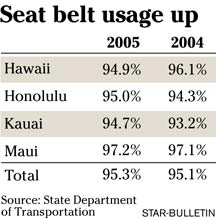Isles second in
seat belt use
Only Arizona ranked higher
in a campaign to get motorists
to buckle up, data shows
Hawaii earned the nation's No. 2 spot, behind Arizona, for seat belt usage with 95.3 percent of motorists buckling up during this summer's "Click It or Ticket" campaign, state officials say.
![]()

"The ultimate credit goes to the public," said Honolulu police Capt. Jose Gaytan, of the Traffic Division. "We hope they just keep on without the stepped-up enforcement."
He said the numbers show the public has gotten the message that seat belts and child restraints do prevent injury and save lives.
All four county police departments participated in the May 23-June 5 campaign, issuing 2,483 tickets this year compared with 3,169 last year.
University of Hawaii surveyors counted drivers and passengers across the state to determine seat belt usage. Maui motorists did best at 97.17 percent use, followed by Oahu at 95.04 percent, Hawaii with 94.91 percent and Kauai at 94.66 percent.
Drivers and passengers buckled up more often when traveling at highway speeds than at lower speeds -- 96.43 percent wore seat belts at 55 mph as compared with 92.68 percent at 25 mph, according to the survey.
"We try to remind drivers that most accidents occur a mile from your house," said Scott Ishikawa, state transportation spokesman. "There is this misconception that 'I don't have to wear my seat belt if I'm driving to the store,' when actually most accidents occur closer to the home."
The "Click It or Ticket" campaign's media ads targeted the largest groups of unbuckled motorists: 18- to 25-year-olds and pickup truck drivers.
Car drivers tended to wear seat belts more often than truck drivers -- 97.03 percent compared with 92.6 percent, the UH surveyors said. Van and sport utility vehicle drivers fell in between at a rate of 95.36 percent and 95.52 percent, respectively.
The campaign also focused on pickup truck drivers because trucks and SUVs are two to three times more likely to roll over, and occupants can be ejected from the vehicles if they are not buckled up, Ishikawa said.
Motorists on the weekends tended to be more lax in their seat belt use, 93.88 percent, as compared with their weekday use, 95.58 percent, the survey said.
Ishikawa credited a combination of factors for the good results, including enforcement, effective TV ads, a catchy slogan, highway signs and higher seat belt use fines.
The $92 ticket (a $45 fine and $47 in administrative costs) for seat belt violators is high among the states. In some states where usage is at 50 percent to 60 percent, fines were relatively low at $25 to $30, Ishikawa said.
E-mail to City Desk
[News] [Business] [Features] [Sports] [Editorial] [Do It Electric!]
[Classified Ads] [Search] [Subscribe] [Info] [Letter to Editor]
[Feedback]
